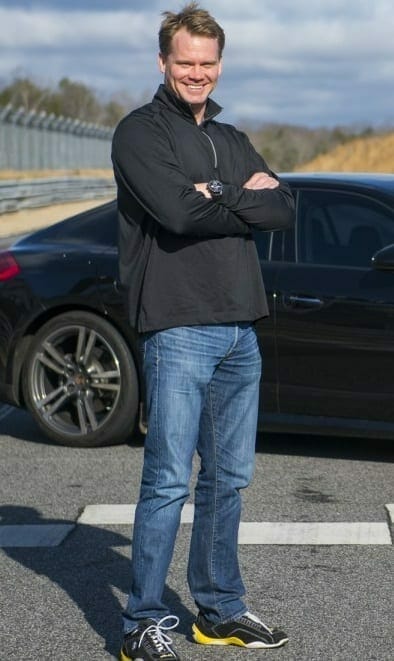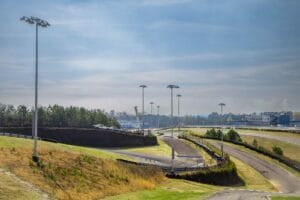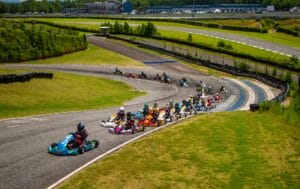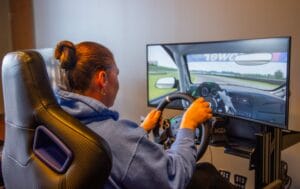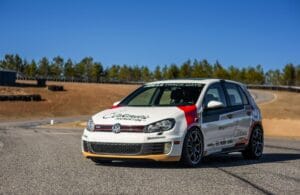They said it was impossible. They said that no one — not the state government, nor investors, nor the average joe — would get behind the idea of another motorsports track near Atlanta. “Everyone I approached in the industry said there’s no way to be able to get this done, and it’s just not going to happen,” Atlanta Motorsports Park founder and owner Jeremy Porter recalls. “They kept telling me: ‘Everybody’s tried over eight times since 1967 and failed.’”
Now, with 450 permanent members and hundreds more visitors attending every year, it would seem that the “impossible” was very much within grasp. Jeremy’s triumph against the odds is hardly serendipity, either, standing more as a victory of passion over so-called “common sense,” and a testament towards following your heart wherever it may lead you.
A Vision of Smooth Asphalt Cutting Through the Georgia Mountains
A project to construct another track on the site of Road Atlanta birthed the original plan for Atlanta Motorsports Park. Visions of a 1.25 mile F1-style road circuit surrounded by club tracks and kart-racing circuits impelled Jeremy to start dreaming big.
While that plan never came to fruition, it planted the seed that later grew into a grassroots movement to bring Jeremy’s unique vision to life. He shelved his track design and completed business plan, but he did not shelve his ambition. All the while, a dream incubated for creating a unique playground dedicated to those who had petrol flowing through their veins.
In 2007, that plan was dusted off and removed from its shelf. Wanting it to be as complete as possible, Jeremy began to call all the other racetracks and motorsports country clubs he could think of, asking them what worked for them in the past and what didn’t. Not content with just one opinion, Jeremy went down their employee lists, using any phone number he could get his hands on. “I aggravated a lot of people in the industry,” he confesses, “but the basic idea was I wanted to be able to learn from their mistakes and channel ideas they wish they had used.”
With these insights under his belt, Jeremy began to run the business plan by friends in the hope that they could help him get the project off the ground. “I had no experience in development, construction, raising capital or running a racetrack in general, so I was looking for all the assistance I could get.” Unfortunately, the timing could have been better. Jeremy started his quest in earnest in 2007 and officially launched the project in October of 2008, right in the midst of both the recession and a spike in gas prices.
Nevertheless, Jeremy took his binder full of presenting points to the opening of Petite LeMans. Over 250 people were in attendance. “We sold two memberships that night, and I didn’t even know where we were going to build the track,” Jeremy remembers. “But at that point I knew we had something. So, basically there was open road in front of me and the potential of people with torches and pitchforks behind me.”
Channeling this initial momentum, Jeremy began to ignore the negativity barraging him from all sides in an effort to keep heart. “I stopped watching the news, I stopped reading the newspapers, and if anyone said they were in real estate, I would turn around and walk away before they could tell me how my project was going to fail.”
From a Zoning Fight to the Home Stretch
With a few members under his belt, Jeremy began to seek for a way to take his project from a dream to a reality. “I called Emory Lipscomb, the leading zoning attorney in Georgia, and asked him if he could help zone the track for me. Lipscomb said ‘I don’t want to be cynical in my old age, but it would take a $70,000 retainer and we’d end up with about $200,000. Even still, there’s no way in Hades you’re going to get that race track zoned.”
Forging ahead with his do-or-die attitude, Jeremy put money down on the intended property, a tract of land in Dawsonville mountains where American auto racing once began. With have no way of turning back, he decided to attend the first zoning hearing in his lifetime: the zoning hearing for his track. “At the zoning hearing, I didn’t even know which way I was supposed to face. I asked if I should face the crowd, or if I face the Planning and Zoning commission. The commissioners laughed at me and said, ‘You face us.’”
Picketers had crowded around the City Hall entrance along with Channel 5, Channel 11 and Talk Radio correspondents. Over 600 people were in attendance, including both motorsports enthusiasts and skeptical locals. “I had death threats, personally, and so did some of the Planning and Zoning Commission.” Insults and accusations were hurled throughout the entire presentation. The complaints ranged from “City slickers just want to invade and tear up our city” to “If you’re a Christian you wouldn’t do this, period — cutting down trees and destroying the land.” Jeremy rebutted: “What do you think God built Noah’s Ark out of? What is your house built out of?”
Despite the uproar and overwhelming skepticism, Atlanta Motorsports Park received the approval from both the Planning Commission and the Zoning Commission. Within a few short weeks, $800,000 in memberships were sold, providing much-needed investment capital as the track began to break ground.
However, the rest of the money was not there yet, and Jeremy could not find anyone willing to provide a reasonable loan. “When we first started talking about AMP, we had banks and people that were interested before the bottom fell out of the financial side of America. Then we had no one.”
One group that was much more eager to get working were commercial contractors. Jeremy recalls: “I said, ‘Do you guys want to work?’ And they all said ‘Of course!’ We had 32 bids on grading alone, and you were likely to only get one or two in the past.” Yet when it came to working out payment arrangements, many balked when Jeremy told them he could not find a construction loan. He began to ask the most-qualified contractors if they were willing to finance the work. “They all laughed and said ‘No way!’ But I told them ‘Then you won’t work, and neither will I.”
With the case made plain and several contractors convinced, Jeremy worked out payment arrangements. The first shovels began to hit the dirt. “The real scary part was, during the recession, people’s equipment would be repossessed. We would show up, and there would be no people there to work on the project for several days or weeks at a time.” Memberships were sold along with equity stakes as needed to continue paying down the debt and keep the contractors solvent. Jeremy made payments every single month nearing $280,000 on average for a 16-month period.
The Plan Comes Together
With grading and the initial track layout underway, Jeremy began to pursue the finishing touches. He approached manufacturers of guard rail systems, retaining wall systems and other important infrastructural components using the same tenacity he dogged his contractors with. Commercial builder Mod Space became a close partner on erecting the garages and other buildings, along with many other businesses persuaded to bend their typical terms.
During this time, the original track designer Hermann Tilke approached AMP about going through a redesign to improve the final circuit layout along with the site plan for all the surrounding buildings. Jeremy rebuked, saying “We can’t afford it! Your budgets for bathrooms are more than our entire budget for the park!” Still, Tilke insisted that they redesign. They wanted to be part of the “American project,” and they opined: “No one else is building race tracks right now.” After some back and forth negotiation, Jeremy and Tilke found a price point they could both agree upon.
In total, with the help of understanding contractors, the park was built for 55 percent of the estimated cost that Jeremy would have faced before the recession. His struggles to win over the faith of others in the midst of a financial downturn turned out to be a blessing in disguise.
All said and done, Jeremy was able to raise over $2.5 million dollars in membership fees before the Atlanta Motorsports Park ever officially opened its doors. The vast majority of that money went towards paying down contractors for the first few years, month-by-month, until the park steadily climbed up into the black.
A Triumph of Faith Over Fear
With the worst uncertainties behind him, Jeremy and the rest of the dedicated AMP crew finally earned the time to sit back and look upon all that they had accomplished. In the face of doubt, naysaying and sheer mockery, they had managed to put something together unlike anything else in the Southeast, perhaps the whole world.
AMP’s victory is not just a victory for private enterprise or its passionate members, but for motorsports as a whole. Built on land that once housed a large-scale moonshine and bootlegging operation, the beginnings of American auto racing are literally embedded into the track’s foundation. Dawsonville was where NASCAR began, after all, with bootleggers who got their start trying to outrun the law before trying to outrun each other on the dirt track.
Now, the legacy of souped-up American steel is retread by some of the fastest, most beautiful and most exotic vehicles seen on the planet. It is no coincidence that they make their mark just a few feet above those who made the dream of American professional motorsports racing a reality through their own enterprising tenacity and unwillingness to take “no” for an answer.
As AMP breaks ground on our upcoming expansion, who knows what vestiges of moonshine stills or rusted, forgotten stock car hulls lie beneath the soil? Just as it has always been, the future means reflecting on the past and learning the lessons of those who blazed the trail before us, their taillights still visible, guiding us forward through the still-untamed and uncertain road ahead.
